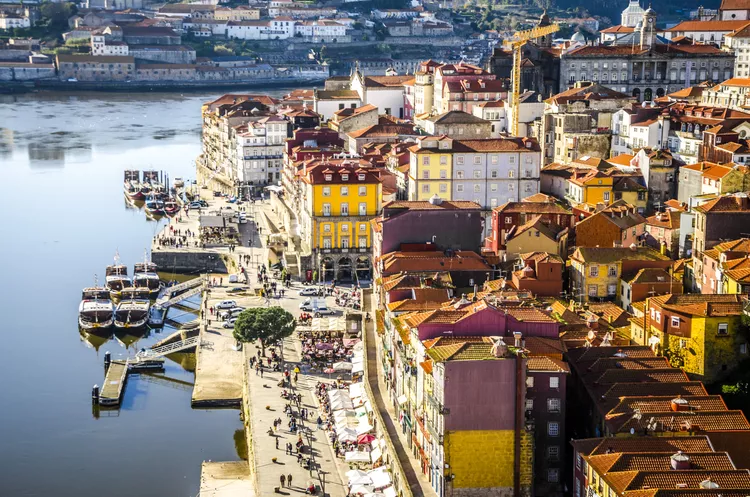7 Best Places to Visit in Portugal:
Portugal is often more affordable than Spain and boasts a culture that is distinctly unique. Instead of flamenco, you’ll find fado; rather than sherry, savor port wine, and instead of tapas, enjoy generous plates of fish or meat, complemented by boiled potatoes and vegetables.
This article outlines the top cities and regions to explore in Portugal, including Lisbon, known for its fado music and the historic Alfama district, as well as Porto, celebrated for its renowned port wine. Though Portugal is a smaller country, it offers stunning rural landscapes and beautiful coastal beaches for visitors to enjoy.
1. Lisbon
:max_bytes(150000):strip_icc():format(webp)/GettyImages-599705349-5b0c4c9c3418c6003865db6d.jpg)
Lisbon, the capital of Portugal, is a vibrant and lively city that offers an eclectic mix of attractions. Visitors can immerse themselves in the rich culture, sampling traditional fado music and renowned Portuguese wines, including exquisite port wine.
Additionally, Lisbon effectively combines modern amenities with the historical charm found within the narrow alleyways of the centuries-old Alfama district. Its extensive transport network, including a night train service from Madrid, makes it a convenient starting point for exploring Portugal.
2. Porto
:max_bytes(150000):strip_icc():format(webp)/GettyImages-832195776-5b0c4d0104d1cf0036e7b1c9.jpg)
Porto, known as the home of port wine, offers stunning views along the Ribeira wharf, where visitors can enjoy picturesque scenes of wine cellars across the Douro River. The opportunity to indulge in port tastings while surrounded by Porto’s charming historical architecture is not to be missed.
Furthermore, Porto serves as an excellent base for exploring the nearby Douro Valley, famous for its breathtaking vineyard landscapes. Easily accessible from Galicia, traveling from Santiago de Compostela to Porto only requires a morning, although a train change in Vigo is necessary.
3. Coimbra
:max_bytes(150000):strip_icc():format(webp)/GettyImages-927427698-5b0c4da3eb97de003734337f.jpg)
Coimbra is renowned for its own distinctive style of fado music, known as Coimbra fado. The city, home to one of the oldest universities in Europe, attracts a lively student population. When visiting during term time, you might encounter students in traditional academic attire.
Coimbra’s size allows for effortless exploration on foot, providing an excellent opportunity to absorb its culture and history.
4. Faro and the Algarve
:max_bytes(150000):strip_icc():format(webp)/GettyImages-688072885-5b0c4e2a04d1cf0036e7df6a.jpg)
While Faro may not be the foremost destination in the Algarve, it certainly has its own charm, featuring an old town and several accessible beaches from the city center. Moreover, Faro serves as a strategic starting point for further exploration across the entire Algarve region, given the presence of an airport and its role as a bus and train hub.
5. Evora and the Alentejo
:max_bytes(150000):strip_icc():format(webp)/GettyImages-905583210-5b0c4e98ba61770036f43ae3.jpg)
Evora, while known for its prestigious university, is far more than just an academic hub. It boasts one of the finest medieval towns in Portugal, which has been recognized as a UNESCO World Heritage Site. As a result, Evora presents a perfect base for discovering the Alentejo region and its incredible wineries.
6. Braga
:max_bytes(150000):strip_icc():format(webp)/GettyImages-177249327-5b0c4f1a8023b90036beb708.jpg)
Braga is Portugal’s third-largest city, celebrated for its relaxed atmosphere and easily navigable streets. Visitors can witness traces of its medieval heritage, including a 12th-century cathedral. The significant highlight is the Bom Jesus Sanctuary, perched on a hill that offers breathtaking views of Braga. Visitors can either tackle the stunning zigzag baroque staircase or take a scenic funicular ride to the sanctuary.
7. Guimaraes
:max_bytes(150000):strip_icc():format(webp)/GettyImages-119828978-5b0c4fb5ff1b7800361bae29.jpg)
Recognized as a European Capital of Culture in 2012, Guimaraes offers a vibrant blend of history and modernity. The city is home to an ancient medieval center and a castle that dates back over a millennium. For those seeking fresh air and stunning views, a cable car ride to an overlooking park provides a delightful experience.




